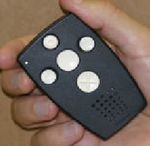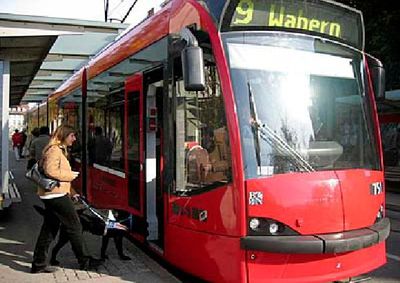Jun 25, 2008By 2013, national and European Union regulations require that public transit operators across Europe provide more information for blind and visually impaired riders. A Swiss public transport agency, Verkehrsbetriebe St. Gallen (VBSG), is rolling out an RFID-based system enabling blind riders to check transit information at bus stops, as well as determine the destination of passing buses and flag them down.
Trials of the system, known as PAVIP (Personal Assistant for Visually Impaired People) and developed by Bones Inc., began in May of this year. St. Gallen's entire fleet of 70 public buses were equipped with active ultrahigh-frequency (UHF) RFID modules that can both receive and transmit data, and the city's 260 stops were fitted with passive high-frequency (HF) RFID tags. Fifteen blind users are currently testing the system, and St. Gallen plans to launch a full-scale pilot with up to 250 blind riders throughout the city, beginning in mid-August.

Bones, which is based in St. Gallen, manufactures RFID-enabled personal digital assistants (PDA) for the visually impaired. The cornerstone of the PAVIP project is the Bones Milestone—a small handheld device containing an HF RFID reader, a UHF RFID transceiver (the same type of module installed on the buses), a digital voice recorder and an audio player capable of playing MP3 files, as well as all other major digital audio formats.
The Milestone's built-in HF RFID reader consists of a Texas Instruments RFID interrogator IC, the TRF7960, which supports passive 13.56 MHz tags complying with the ISO 14443A, ISO 14443B, ISO 15693 and ISO 18000-3 RFID standards. The handheld's active UHF RFID reader is comprised of a Radiocrafts RC1280 transceiver module. The Milestone costs €350 ($551) in a basic configuration, and approximately €500 ($787) for the version used in the transit trials.
"What's important for the blind is not to have 20 gadgets around the belt, not looking like a cowboy with guns," says Bones' managing director, Stephan Knecht. "The blind want to be independent and mobile."
The system has two components involving both active and passive RFID. Users approach and wave their Milestone device in front of a sign printed with the bus line's timetable. The sign contains a passive 13.56 MHz RFID tag encoded with route information for buses passing that stop. The Milestone device then reads that data aloud to the user.

According to Knecht, Bones chose RFID for the technology's versatility. "It was the easiest thing to put on a bus stop," he says, "because it [an RFID tag] is cheap, it works, it is safe against vandalism and it's very suited to the needs we have, which is to store information."
PAVIP's active RFID transceivers employ a proprietary protocol transmitting at 868 MHz. The original plans for the system involved the 2.4 GHz spectrum, but Knecht says signal interference from power lines and mirrored bus windows required a shift to lower frequencies. Once those problems were resolved, he states, the frequency-hopping RFID "worked brilliantly."
"We are convinced that this new technology will be very helpful for blind people," says Ralf Eigenmann, managing director of VBSG. "I don't expect any maintenance costs. For us, we just have to place the RFID chips and the technology in the buses. If we build new stops, we'll integrate these chips into the new stops." VBSG, he says, might also consider utilizing RFID as a form of ticketless travel on its bus system if the transit authority continues to have a positive experience with the technology.
According to Knecht, the pilot project will cost a total of 774,000 Swiss francs ($740,226). The program is funded jointly by VBSG, the Swiss Federal Department of Home Affairs, the Swiss Federation of the Blind and Visually Impaired and Bones, which donated its engineering time and interrogators for users in St. Gallen.
In addition to public transit applications, Bones' Milestone device also utilizes RFID for a variety of other purposes. Users can purchase passive HF RFID tags and affix them to medicine bottles and other objects. They can also record voice memos associated with particular tags, such as a pharmacist giving directions for taking medicine, then replay the memos when the Milestone reader scans the tag. Additionally, the device contains a slot for SD memory cards, commonly found in cameras, that can store recorded books for the user to listen to.
The Milestone device with RFID readers was released last year, Knecht says, and currently has 3,000 to 4,000 users worldwide. Bones sells boxes containing an assortment of 10 passive HF tags for approximately $10 apiece.

